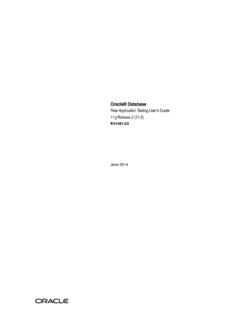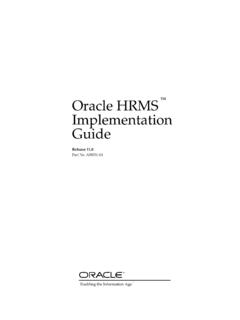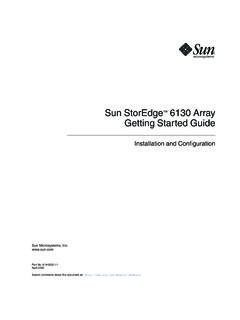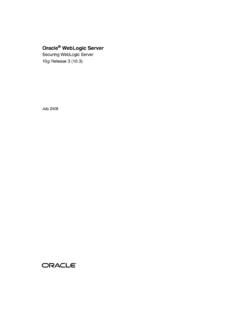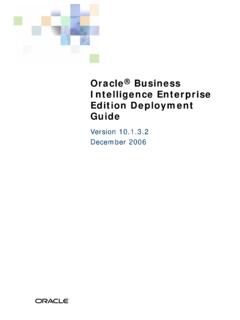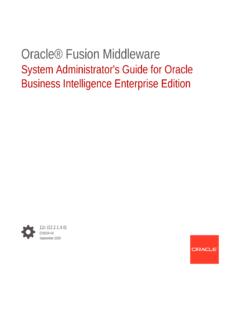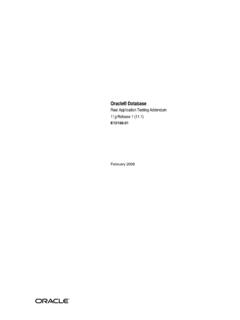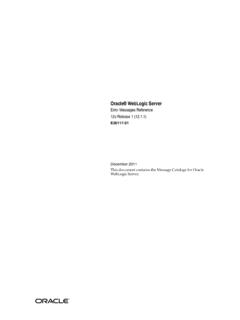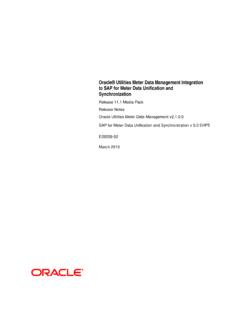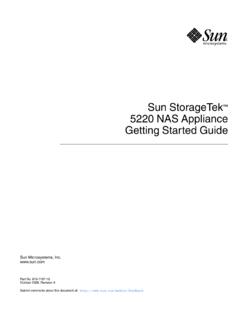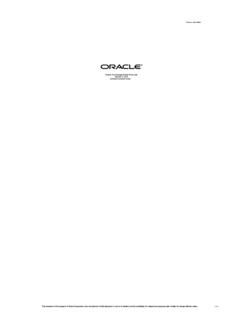Transcription of Oracle FLEXCUBE Universal Banking® 12
1 Oracle FLEXCUBE Universal Banking Development Overview Guide Release Part No. E49740-01. June 2012. FD01-01-01 Development Overview Guide 1. Contents 1 Audience .. 3. Related Documents ..4. Conventions ..4. 2 Introduction .. 5. How to use this Guide ..5. 3 FLEXCUBE UBS Development - Introduction ..5. FLEXCUBE UBS Functional architecture overview .. 6. FLEXCUBE UBS Technical architecture overview .. 6. User Interface tier ..7. Process tier ..7. Application and Integration tier ..7. Database tier ..7. FLEXCUBE UBS data 8. FLEXCUBE UBS Framework .. 8. User Interface framework .. 8. Gateways ..9. Branch workflow ..9. Reports ..9. BPEL process flows .. 9. FLEXCUBE UBS Application components & Tools to be used.
2 9. FLEXCUBE Programming Language Overview .. 10. FLEXCUBE Data Model .. 10. FLEXCUBE UBS Object Naming Conventions .. 11. Module .. 11. Function IDs .. 13. Table Names .. 13. Package Names .. 14. Views .. 14. Triggers .. 15. Synonyms .. 15. File extensions .. 15. RAD object naming conventions .. 16. FLEXCUBE Hand Coded / Manually developed Components .. 17. 4 FLEXCUBE UBS Application Developer Documents .. 17. Document classifications .. 17. Document contents .. 19. 5 Developer Glossary .. 22. 6 List of Figures .. 24. 7 List of Tables .. 24. FD01-01-01 Development Overview Guide 2. 1 Preface This Development Overview document provides the bird's eye view of FLEXCUBE UBS. Application development.
3 It touches the concepts, frameworks, tools required and documents available for guidance. Audience This Developer Overview book is intended for authorized FLEXCUBE UBS Application Developers who are expected to perform the following task: To develop a Function ID(User Interface Screen). To develop a Web Service To develop a Notification To Extend FLEXCUBE functionality using with extensibility To Interface FLEXCUBE with external systems using Generic Interface To upload data into FLEXCUBE using upload adaptors To use FLEXCUBE UBS framework tools To develop BIP Reports To develop OBIEE Repository files To debug FLEXCUBE at run time To Analyze and fix FLEXCUBE UBS bugs To Use this manual, you need conceptual and working knowledge of the below: Table Proficiency and resources Proficiency Resources FLEXCUBE Functional Architecture Training programs from Oracle Financial Software Services.
4 FLEXCUBE Technical Architecture Training programs from Oracle Financial Software Services. Working knowledge of Web based applications Working knowledge of Oracle Database Oracle Documentations Working knowledge of PLSQL developer Respective vendor documents Working knowledge of PLSQL & SQL. Language Working knowledge of XML files FD01-01-01 Development Overview Guide 3. Related Documents Refer the below documents for more information on FLEXCUBE UBS Application development. 1. FCUBS-FD01-01-01-Development Overview Guide 2. RAD. a. FCUBS-FD02-01-01-RAD Getting Started b. FCUBS-FD02-02-01-RAD Function ID Development Volume 1. c. FCUBS-FD02-02-01-RAD Function ID Development Volume 2. d. FCUBS-FD02-03-01-RAD Web Service Development e.
5 FCUBS-FD02-04-01-RAD BIP Report Integration f. FCUBS-FD02-05-01-RAD Notification Development 3. Extensibility a. FCUBS-FD03-01-01-Extensibility Getting started b. FCUBS-FD03-02-01-Extensibility Reference Guide c. FCUBS-FD03-03-01-Extensibility By Example Volume 1. d. FCUBS-FD03-03-02-Extensibility By Example Volume 2. 4. Interface a. FCUBS-FD04-01-01-Interface Getting started b. FCUBS-FD04-02-01-Generic Interface Configuration Guide c. FCUBS-FD04-03-01-Upload Adapter Development Guide 5. Tools a. FCUBS-FD05-01-01-Tools-Getting Started b. FCUBS-FD05-02-01-RAD-Reference c. FCUBS-FD05-02-02-RAD-Installation and Setup d. FCUBS-FD05-03-01-DDL-Reference e. FCUBS-FD05-04-01-TrAX-Reference 6. Support a.
6 FCUBS-FD06-01-01-Support Getting started b. FCUBS-FD06-02-01-Support By Example 7. Reports a. FCUBS-FD07-01-01-Report Getting started b. FCUBS-FD07-02-01-BIP Report Development Guide c. FCUBS-FD07-03-01-OBIEE repository Development Guide 8. Data model a. FCUBS-FD08-01-01-Data Model getting started Conventions The following text conventions are used in this document: Convention Meaning boldface Boldface type indicates graphical user interface elements (for example, menus and menu items, buttons, tabs, dialog controls), including options that you select. FD01-01-01 Development Overview Guide 4. italic italic type indicates book titles, emphasis, or placeholder variables for which you supply particular values.
7 Monospace Monospace type indicates language and syntax elements, directory and file names, URLs, text that appears on the screen, or text that you enter. 2 Introduction How to use this Guide The information in this document includes: Chapter 2, Introduction . Chapter 3, FLEXCUBE UBS Development Introduction . Chapter 4, FLEXCUBE UBS Application Developer Documents . Chapter 5, Developer Glossary . 3 FLEXCUBE UBS Development - Introduction FLEXCUBE UBS Application development consists of three parts: Framework development Tools development Application components development using Framework/Tools This document and associated documents are intended to guide FLEXCUBE UBS. Application component development.
8 FD01-01-01 Development Overview Guide 5. FLEXCUBE UBS Functional architecture overview The given below diagram provides the functional architecture of the FLEXCUBE UBS. Refer the respective FLEXCUBE UBS user manuals to know functionality. Fig - FLEXCUBE UBS Functional architecture FLEXCUBE UBS Technical architecture overview The diagram depicted below represents the FLEXCUBE technical architecture and it consists of the following tiers: User Interface tier Process tier Application and Integration tier Database tier FD01-01-01 Development Overview Guide 6. Fig - FLEXCUBE UBS Technical architecture User Interface tier The user interface of the application is light-weight in nature and based on JavaScript and XML.
9 The communication between the browser and the web server is using XML. The rendering is done on the client using XSLT. The user interface is configurable. The screen can be easily adapted to different languages. Process tier Oracle FLEXCUBE provides for processes to be developed around the natively provided application. One can define processes using Oracle BPEL Process Manager and integrate the same into the application's user interface framework. When deployed in a process centric model, Oracle FLEXCUBE provides a task-based user interface. By default, Task based UI is offered for the branch platform. Application and Integration tier Oracle FLEXCUBE does not differentiate partner channels from its own native user interface when it comes to data processing.
10 The Application and Integration tier provides the message handling, session management (for the native user interface). and transaction management in the application. Database tier The back-end is a relational database management system Oracle 11g. The database tier ensures integrity of data and also provides business logic written mainly in Oracle PL/SQL from the Oracle database. FD01-01-01 Development Overview Guide 7. FLEXCUBE UBS data flow The below self explanatory diagram represents the FLEXCUBE UBS data flow at run time. Fig 33 - FLEXCUBE UBS Data flow UI and State HTTP Web Services JMS Management Client Client Client Menu Browser UI XML Client XML. XML / HTTP XML / SOAP Task List XML.
